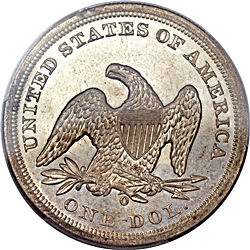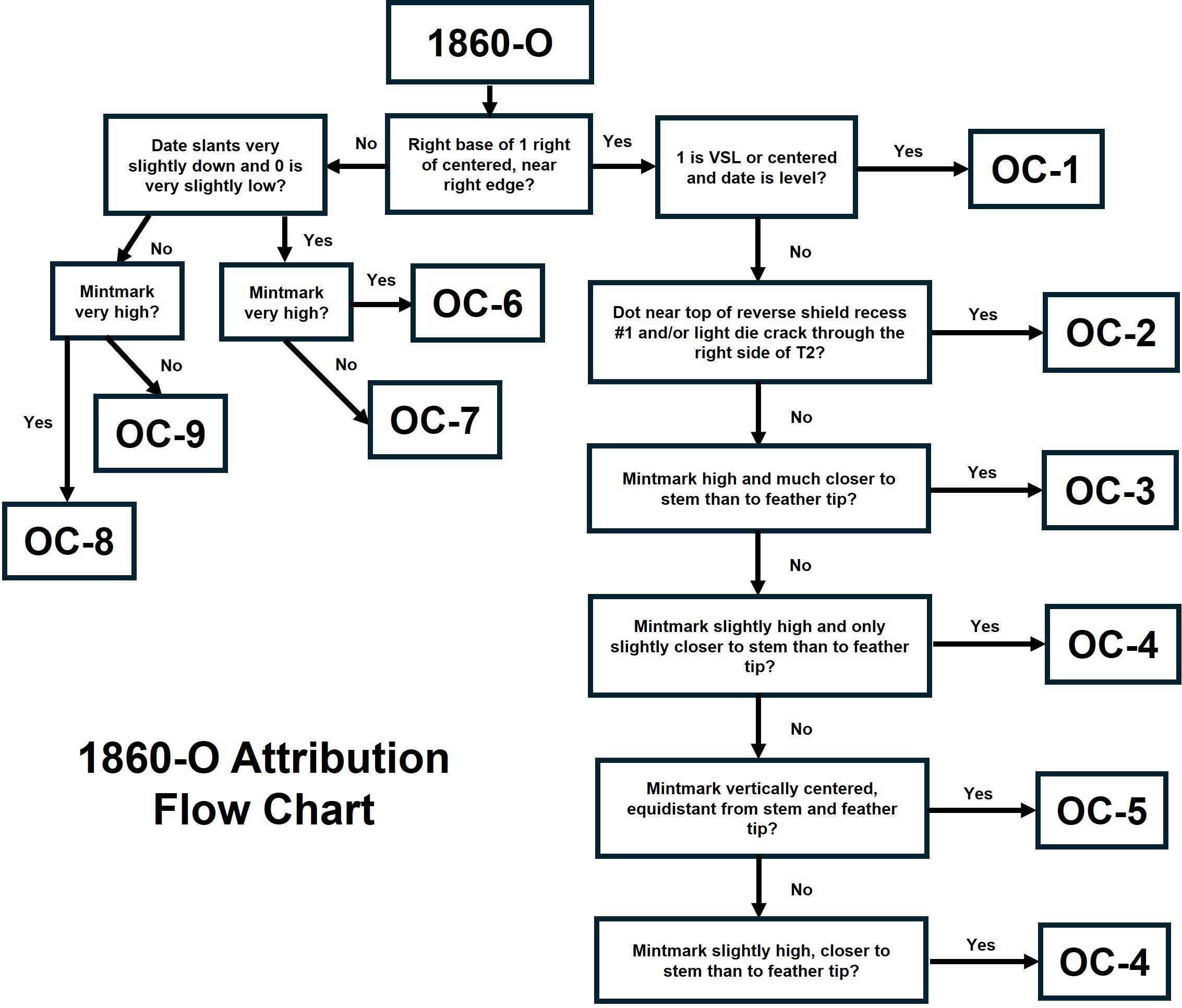 |
1860-O
 

|
 |
General Comments
|
| |||||||||||||||||||
As noted above 1860-O examples are usually well struck. In fact, if strike is one of your strong interests, this and the 1859-O are among the best dates in the series for finding examples that are sharply struck. It seems to be the rule rather than the exception. I’ve seen a few examples that display softness on the right-side stars, including several MS64 and MS65 coins, but it’s almost tougher to find a coin that displays a weak strike than to find one that’s well-defined. Similarly, I’ve seen a few that show some flatness on the eagle’s left talon, but only a few. This is one of the few dates that almost never shows weakness on the upper left edge of the eagle’s wing. They may be common, but at least you can find them well struck!
1860-O surfaces are usually frosty. They can be found prooflike, but with a large mintage spread among the ten die pairs identified so far, the runs were long enough that most of the coins exhibit frosty surfaces.
1860-O Die Marriages
Four obverse dies were paired with six reverses to strike a total of ten die marriages. None are particularly rare, with the OC-10 at R3+ and 3 others at R3 being the scarcest. The rest can be considered common. The following table summarizes the known die marriages:
Click the links below to view the details of the die marriages.
Die Marriage |
Rarity |
Obverse Die |
Reverse Die |
Estimated Survivors |
| OC-1 | R1 | 1 | 1859-O B | 1400 |
| OC-2 | R1 | 2 | 1859-O B | 3100 |
| OC-3 | R3 | 2 | A | 350 |
| OC-4 | R2 | 2 | B | 730 |
| OC-5 | R3 | 2 | C | 330 |
| OC-6 | R2 | 3 | D | 1000 |
| OC-7 | R2 | 3 | E | 790 |
| OC-8 | R1 | 4 | D | 1750 |
| OC-9 | R3 | 4 | C | 320 |
| OC-10 | R3+ | 2 | E | 230 |
1860-O Varieties
The only die marriage that I consider a true variety is the early state of OC-2. It exhibits a repunched date. A photo of this repunching is included with the detailed description of OC-2 found later in this section. The repunching is very minor. I didn’t feel that this variety was significant enough to be included in my Top-30 list.
Breen (reference 20) lists three varieties:
- BR5464, heavy numerals;
- BR5465, very thin numerals, heavy mintmark;
- BR5466, very thin numerals, light mintmark.
I believe that all three of the Breen varieties are simply die states created by die polishing. Light mintmarks are OC-1 and OC-2, which used a reverse die first used in 1859 and polished several times before its use in 1860; and OC-8, in a late reverse die state. Light numerals are OC-8 and OC-9. Obverse 4 was heavily polished during the striking of the OC-8 die marriage, creating a date that appears slightly weak. Reverse C was also heavily polished at that time, weakening ONE DOL at the base of the reverse. However, the mintmark was not significantly affected, and remained bold. The remaining die marriages were less polished and would be considered as Breen’s heavy numeralss noted.
1860-O Emission Sequence
1860-O dies were used long enough to allow conclusive determination of the emission sequence. Only the placements
of OC-7 and OC-8 are arbitrary, as noted.
Emission Order |
Die Marriage |
Comments |
| 1 | OC-1 | We assumed that the marriages which used the transitional reverse die came first. |
| 2 | OC-2 | Advancing reverse die cracks established OC-2 as following OC-1. |
| 3 | OC-3 | Slight additional Obverse 2 die polish indicates that OC-3 followed OC-2. |
| 4 | OC-4 | Slight additional Obverse 2 die polish indicates that OC-4 followed OC-3. |
| 5 | OC-5 | Slight additional Obverse 2 die polish indicates that OC-5 followed OC-4. |
| 6 | OC-6 | No shared dies with OC-5, but we know that OC-7, OC-8, and OC-9 followed OC-6, and that OC-9 followed OC-5. |
| 7 | OC-7 | Slight additional Obverse 3 die polish indicates the OC-7 followed OC-6. The placement of OC-7 before OC-8 is arbitrary. |
| 8 | OC-10 | Growth of Reverse E die cracks indicates that OC-10 followed OC-7. The placement of OC-10 before OC-8 is arbitrary. |
| 9 | OC-8 | Reverse D die deterioration indicates that OC-8 followed OC-6. The placement of OC-8 after OC-7 and OC-10 is arbitrary. |
| 10 | OC-9 | Obverse 4 die wear indicates that OC-9 followed OC-8. Reverse C die cracks indicate that OC-9 followed OC-5. |
1860-O Quick Finder Chart
Several 1860-O dies are similar, but in all cases there are notable markers that allow relatively easy attribution.
Die Marriage |
Obv Die |
Rev Die |
Right |
Keys |
| OC-1 | 1 | 1859-O B | RE | Obverse: Finished under the chin. 1 is VSL. Reverse: A tiny lump at the top of the first shield recess. Other markers at the top of recesses #2 and #3. Most examples exhibit a radial die crack through the right side of T2. |
| OC-2 | 2 | 1859-O B | B | Obverse: RB of 1 is B. 1 is SH. The date slants VS down. A circular die line on Miss Liberty's stomach. Reverse: A tiny die pit at the top of the first shield recess. Other markers at the top of recesses #2 and #3. All examples of this die marriage exhibit a radial die crack through the right side of T2 and a crack crossing the base of D STATES OF. |
| OC-3 | 2 | A | B | Obverse: RB of 1 is B. 1 is SH. The date slants VS down. A circular die line on Miss Liberty's stomach. Reverse: Vertical shield line 1-2 extends sharply to 4. Mintmark high, closer to stem, CCW rotation. Die rust lumps around ES. |
| OC-4 | 2 | B | B | Obverse: RB of 1 is B. 1 is SH. The date slants VS down. A circular die line on Miss Liberty's stomach. Reverse: Shield recesses rusty, unfinished except for the upper left quadrant. Tiny die line within left claw. |
| OC-5 | 2 | C | B | Obverse: RB of 1 is B. 1 is SH. The date slants VS down. A circular die line on Miss Liberty's stomach. Reverse: Mintmark centered vertically, farthest left for the year. Die lines in shield recesses. |
| OC-6 | 3 | D | JL of C | Obverse: 1 is VSH, 0 is VSL. No other markers. Reverse: Mintmark is very high, slightly closer to stem. |
| OC-7 | 3 | E | JL of C | Obverse: 1 is VSH, 0 is VSL. No other markers. Reverse: Mintmark slightly high, much closer to stem, no rotation. No other notable markers. |
| OC-8 | 4 | D | JL of C | Obverse: 1 and 0 are SH. On almost all examples a tine slants up and left off the upper left side of the scroll end. Reverse: Mintmark very high, slightly closer to stem. |
| OC-9 | 4 | C | JL of C | Obverse: 1 and 0 are SH. Tine slants up to the left off the upper left side of the scroll end. Reverse: Mintmark centered vertically, farthest left for the year. Die lines in shield recesses. |
| OC-10 | 2 | E | B | Obverse: RB of 1 is B. 1 is SH. The date slants VS down. A circular die line on Miss Liberty's stomach. Reverse: Mintmark slightly high, much closer to stem, no rotation. No other notable markers. |
1860-O Attribution Flow Chart
The flow chart shown below can be helpful in attaining a quick attribution of your 1860-O examples.

| Photo credits:
Obverse and reverse full photos: 1860-O PCGS MS65+ CAC, from the Heritage archives. |
